Life of Buddha
The ‘Life of Buddha’ has been curated from a collection of bronze sculptures at the National Museum, Delhi to represent the works both thematically as well experientially as if one were looking at them while physically present inside a Museum/Art Gallery in the way that objects are placed and lit in a certain way for maximum viewing pleasure.
Curated By Dr. Ajanta Sen
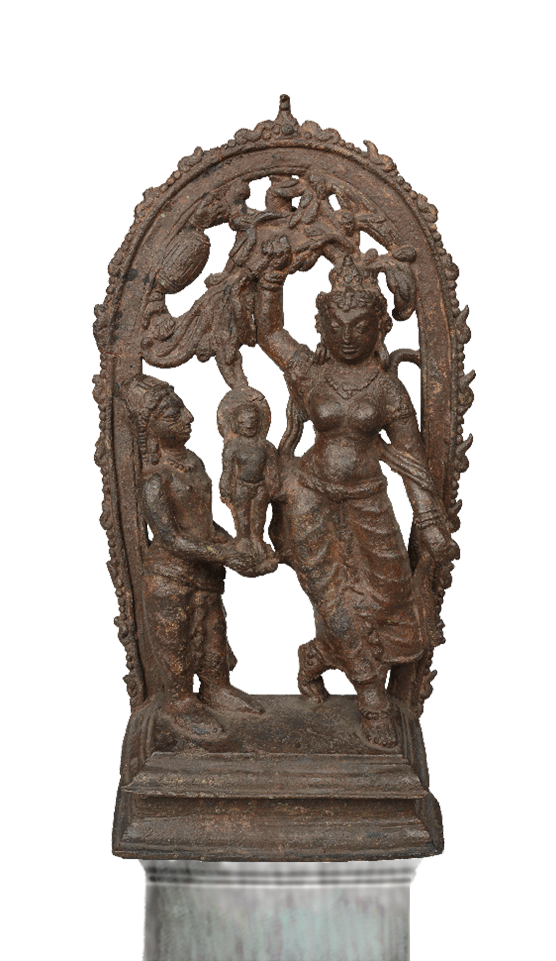
Birth of Buddha
The scene depicts the Lumbinivana, symbolised by the branch of a tree, where Maya, wife of the Sakya chief Suddhodana, retired and delivered the child. On the right, Maya is seen holding the branch of the sala tree with her right hand to take support. On her right is Indra, the thousand- eyed Lord of the Gods, identifiable by his conical cap, receiving the newborn child in his palms. Standing between them is the newly born baby, about to take the first seven steps. Dundubhi or the celestial drum with a palm on each side, to announce the birth of Buddha, can be seen above the branch.

Crowned Buddha
Representation of the Buddha with ornaments and crown is rare. This bronze depicts Buddha seated on a high pedestal. The fingertips of his right hand are in bhumisparsa-mudra (earth-touching pose), signifying the calling of the earth as a witness to his victory over the temptation of Mara and his subsequent enlightenment. His left hand is on the lap in dhyana-mudra, signifying meditation.

Vajrapani
Vajrapani is one of the five Dhyani Bodhisattvaas belonging to the Vajra family presided by the Dhayni Buddha Akshobhya, prior to becoming a Bodhisattva, Vajrapani was a vqjra wielding yaksha who attended to Buddha till his death. He is seated in sukhasana on a circular lotus pedestal. He is holding a chauri (fly-whisk) in his right hand and a vqjra in his left hand. Interesting feature of this statue is that the two earrings feature different designs. He held an important position in Buddhist theology in Nepal till the cult of Indra rose to prevail over that of Vajrapani.

Loknatha (Avalokiteshwara)
Lokanatha, as a form of Avalokiteswara, was widely worshipped in the eastern region. The two -armed deity sits in ardhaparyankasana on a double lotus pedestal provided with a ring of beads at the base. He sits in a tribhanga pose, his right hand displays varada mudra while in the left hand he holds the stalk of a lotus that rises above his shoulder.
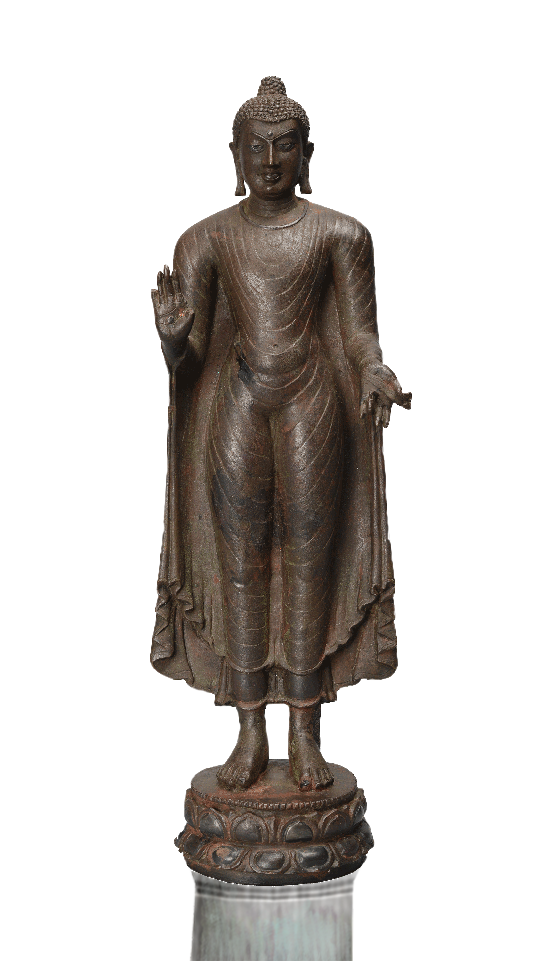
Standing Buddha
The standing image of Buddha was a common feature of Nalanda during the Pala dynasty. The right hand is in abhqya-mudra (gesture of assurance) and the left holds the hem of his garment. The robe covers both shoulders and clings closely to the body, revealing the girdle beneath. Some of the 32 mahapurusha lakshanas (signs of a great man) are represented here: elongated earlobes, the cranial portruberance (ushnisha), tuft of hair on his forehead (Urna), three lines on his neck, webbed fingers and lotus sign on his palm.

Buddha
Of exceptional importance, this is perhaps the only image known to be considered a product of Burma, inscribed with a donatory Sanskrit inscription in Kutila script of eastern India in the 11th -12th cent. The Buddha can be seen as seated cross-legged in bhumisparsha-mudra on a cushion with thick incised meandering design with a kirtimukha in the centre. The base on which the cushion rests is a saptaratha adhishthana with seven graduated projections in front, and is rounded at the back. The pedestal shows a wheel, a woman, a horse, a pot-bellied male, a man with a sword, an elephant and a counchant lion have been identified as the seven jewels, the man with sord representing the general and the lion representing the precious stone. Each of the seven projections is converted into a niche supported on moulded pillars. An inscription is inscribed below at the base.

Votive Stupa
This is perhaps the most elaborately presented metal Votive stupa known from India so far. The square base has four steps (sopana) in four cardinal, directions, leading to pradakshina or a circumambulation path, around enshrined panels in high relief depicting eight episodes from Buddha’s life. The panels surround the terraces on which a lotus supports the dome. Parasol rings tapering upwards in an inverted bell form can be seen. The eight rings of parasol could also represent the ashtanga-marga or the eight-fold path advocated by the Buddha or even the eight vimokha or states of emancipation.
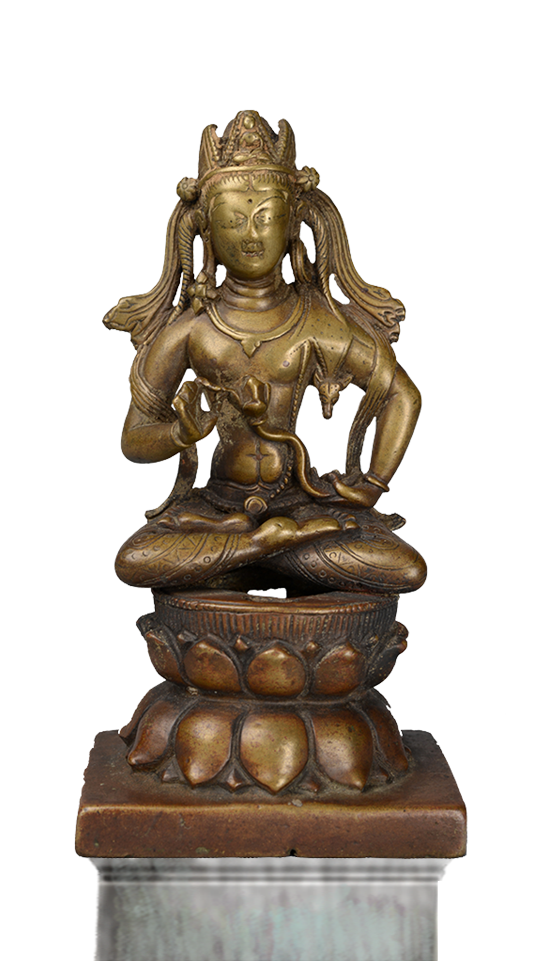
Bodhisattva Raktalokesvara
Raktalokesvara is one of the thirty-one forms of Bodhisattva Avalokitesvara listed in the Sadhanamala. Depictions of this Bodhisattva are rare and hence add to the uniqueness of this image. His eyes are inlaid with silver and the lips with copper. A mrigtf}ina (antelope skin) is drawn over the left shoulder, the antelope's head prominently seen as a silhouette on the arm-pit. Noticeable, however, is his gesture of opening the petals of the lotus held at the breast. The opening of each petal of the lotus held at the chest is symbolic of Buddha's dharmachakra-pravartana-mudra.

Standing Padmapani
This figure of Bodhisattva Padmapani in a standing position is made in gilt bronze. The right hand is in varada-mudra (gift bestowing attitude); in the left hand he holds the stalk of a full-blown lotus. The figure is surrounded by an oval-shaped prabhavali (aureole) having a flaming border and three full-blown lotus with petals inside. The hair is dressed high and three locks fall on each shoulder. He has extended lobes and lines on the neck.

Canda Vajrapani
Canda-Vajrapani is the fierce form of Vajrapani, the Dhyani Bodhisattva of Akshobhya identified by with vajra (thunderbolt) in his hand. He is a protective deity in the Vajrayana Buddhism which is popular in 'Tibet. The deity stands in alidha posture on a lotus pedestal."
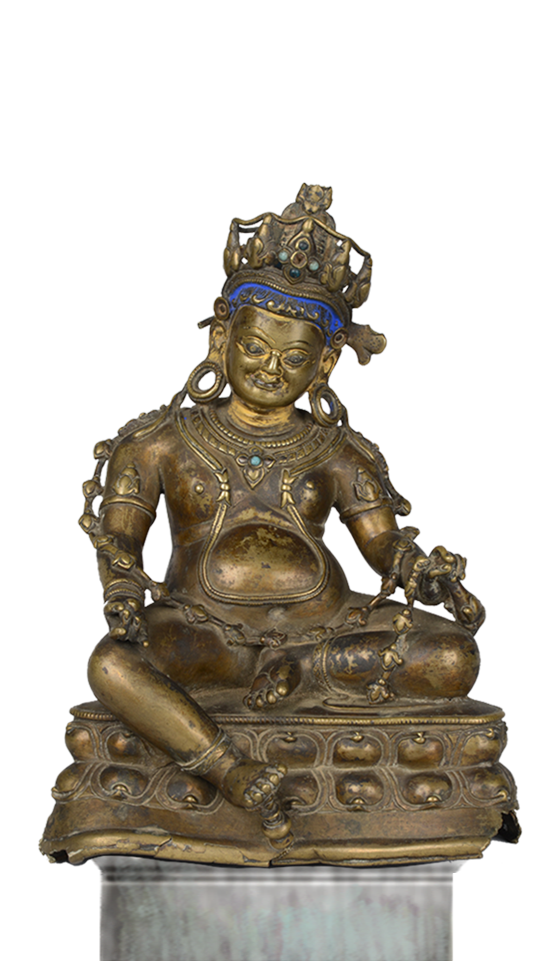
Jambhala
Jambhala is the Buddhist god of wealth, equivalent of the Hindu god Kubera. He is seated on a double lotus pedestal with his right leg resting on a small kalasa symbolizing nidhi or wealth, over which he presides. His left leg is folded and rests on the pedestal. In his right hand he is holding citrus fruit, and with his left hand he is squeezing the neck of a nakula or a mongoose, to emit jewels, seen here as a string of flowers.

Prajnaparamita (Chunda)
Bodhisattva Aavalokitesvara stands on a circular lotus pedestal. The raised right hand is held in abhqya-mudra, while in the left he holds the stem of a lotus flower on which a miniature Amitabha is seated. There is a circular nimbus around his head and the lower garment is reaching the ankles and has drapery folds fastened at the waist. He has extended earlobes and a three-pronged ornamented coronet, a beaded necklace, bracelets, etc.

Vajrasattva
This image of Vajrasattva in gilded bronze shows him seated in padmasana on a double triangular lotus base. He carries double-sided vqjra in his right hand which is placed in front of the chest, while in the left hand he holds a bell. His hair is arranged in top knot fashion. He wears a crown (inlaid with a semi-precious stone in front), necklaces (the pendant of the necklace is inlaid with a stone), armlets, bracelets, lower garment and anklets.
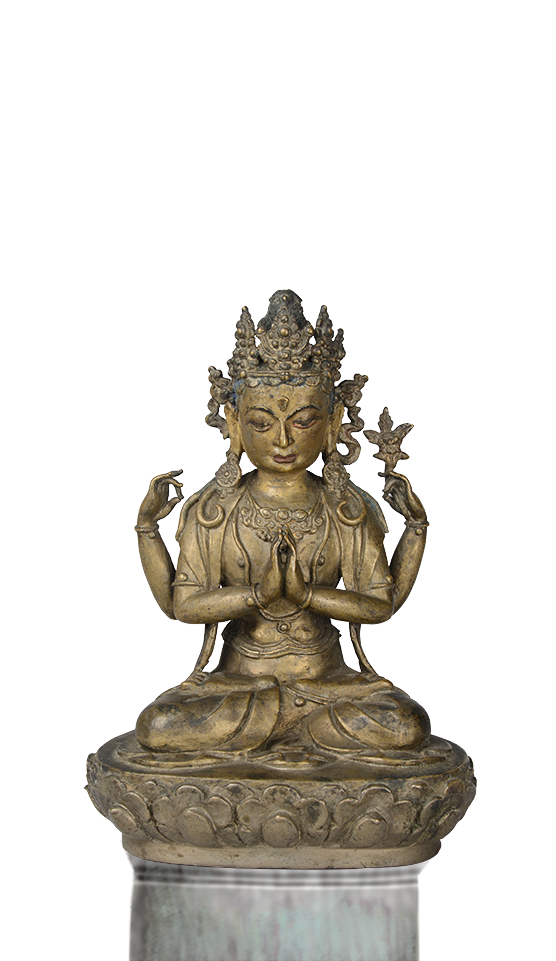
Shadakshari Lokeshvara
Shadakshari Lokeshvara is also one of the thirty-one forms of Avalokitesvara according to the Sadhanamala. He is personified by the six syllable mantra of the Buddhists, "Om mani padme hum'. The four-armed Shadakshari Lokesvara is seated in padmasana on the lotus pedestal. Lower pair of his arms is in anjali mudra against the chest, while the upper right hand is in the attitude of holding the rosary which is not present; the upper left is holding the lotus (utpala). He is adorned with the jewelled crown decorated with five crests.

Maitreya
A standing figure of Maitreya is depicted in gilt bronze. He holds the 'Amritaghata' in his left hand and a rosary in the right, which is in abhqya- mudra. Sash is tied around his thighs and a 'stupa' is depicted against the hair tied high on the head. He is standing on a double lotus pedestal and wears a necklace, armlets, bangle and waistband.

Buddha
Buddha sits cross-legged (padmasana) on a lotus seat, mounted on the lion throne (simhasana) - the latter bearing lotus petal design on three sides. His right hand is in an earth touching gesture (bhumi-sparsha-mudra) and the left is placed on the lap. He bears an uma mark on the forehead and has extended lobes of ears and lines on the neck. The hair is arranged in small schematic spirals with a top knot (Ushnisha). The robe is draped over the left shoulder, leaving the right bare. The frilled edge of the lower garment can be seen in the front.

Vak-Manjusri
"Vak is a form of Manjusri as described in the Sadhanamala. Vak is variously known as Vajraraga Amitabha Manjusri, and Dharmasankhasamadhi. His images are very rare and Nepal is perhaps the only country where this form of Manjusri is worshipped. He is shown to be seated in dhyanasana with his hands joined on the lap in Samadhi Mudra."

Buddha
This is the finest bronze from the famous Phophnar hoard of Gupta-Vakataka images. It shows the Buddha standing on a rectangular pedestal. His right hand is in abhqya-mudra (protection pose) while his left hand holds the hem of his outer garment (sanghatz).

Buddha
This unusual Buddha from the Phophanar hoard shows a garment covering both the shoulders. The features of this image are well defined; the aquiline nose, perforated earlobes, a boyish expression on the face, smiling lips and the half closed downcast eyes add to his benevolent expression. In common with other images from this hoard, he displays the same gestures of hand: the abhqya-mudra with the right, while the left hand holds the edge of his garment. An inscription at the back reads: "" Deyadharmoyam Sakyabhikshukacharya Bhadanta Buddhadasarya / Yadatra puf!Yam tad bhavatu sarvasatvanam"" i.e. 'Gift of Bhadanta Buddhadasa, preacher of the Sakyas."""

Buddha
This is the biggest and the most expressive image from the Phophnar hoard. The broad shoulders, the trivali or three folds on the neck, and the webbed fingers are marks of a great being. Buddha's silver-inlaid, downcast eyes symbolize chitta-ekagrata i.e. concentration of mind. The parasol displays two maladharas who hold a floral wreath above the Buddha's head. The Inscription on the pedestal reads: ""Deyadharmoyam- Nagachari Vira"" i.e. 'Gift of Nagachari Vira.'"
 Video
Video




